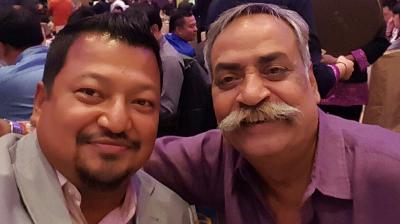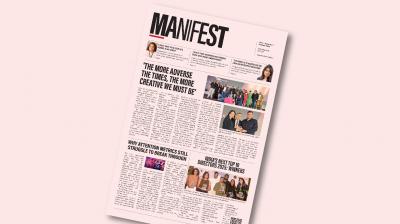One day I received a sudden call from Piyush Pandey. Naturally I was pleasantly surprised. After all, you do not get to speak with the legendary Piyush every day. I was in a client meeting but instinctively picked up the phone. He told me that one of his colleagues from Ogilvy was in Kathmandu for the Everest Base Camp trek and suggested that I meet him. That was the last time I spoke with him (around two years ago in October 2023). Yet that brief conversation remains vivid in my memory.
Over the years, Piyush visited Nepal several times to speak at marketing and entrepreneur forums. Every time, he left us inspired through his work, his words, his humility, his friendliness and, of course, that unmistakable moustache that became his trademark.
I had first heard about him during my Pune days, as many of my friends were beginning their careers in marketing and advertising. Their admiration for the creative movement unfolding in India during the early 2000s inspired me to join advertising. Perhaps that is what led me to join a global advertising firm as a management trainee, even though my parents wanted me to continue our family business. The rest, as they say, is history. This year, I complete 25 years in advertising.
I first met Piyush in person during Ad Asia in India, many years ago at the beginning of my career. Among the small group of Nepali delegates, we were all drawn to his magnetic presence. One of our collective goals during the event was simply to get a photograph with him. That was the kind of influence he carried across South Asia.
Piyush’s body of work was deeply rooted in Indian culture and everyday life, yet it spoke to audiences across borders. At a time when global advertising was dominated by western narratives, he brought back the soul of localised storytelling. Stories that felt authentic not just to India but to all South Asian audiences. He showed us that the most powerful brands are built on local cultural truths. Stories that feel real to the people who live them. He could see the extraordinary in the ordinary, to find beauty in simple human moments and to turn them into ideas that touched millions. From Fevicol’s humour to Cadbury’s cricket celebration and Asian Paints tales of homes (Har Ghar Kuch Kehta Hai), his ads were not just campaigns. They became cultural landmarks that made people smile, cry and feel proud - not just in India but across South Asia.
That spirit of local storytelling inspired many of us in South Asia, including those of us in Nepal, to look inward for creative inspiration. As our markets evolved, especially after the Clean Feed Policy in Nepal and the growing influence of social media, the belief in cultural authenticity based on local insights became even more powerful.
I met him on several occasions afterward including one memorable event in Kolkata, where I shared the same stage with him. I still remember the warmth and kindness he extended to me that day — to a relatively junior person inspired by his aura. He always showed genuine affection for Nepali advertising and the stories emerging from our region. Each time we met in any advertising forums, he would introduce me and say, “Here comes the Nepali boy on a mission to make Nepali advertising noticed.” That phrase continues to motivate me even today.
At times, I would share our work from Nepal and our achievements on Whatsapp and he would often respond with just a few words but always with encouragement. I know that he contributed his inputs during a brief visit for an important child nutrition project in Kathmandu, showing how deeply he cared for ideas that made a difference. We all know Piyush led the creative campaign to end polio in India with UNICEF.
Last week, as we gathered in Beijing for the Ad Asia 2025 Congress, organised by the Asian Federation of Advertising Associations (AFAA) and the China Advertising Association, we received the heartbreaking news of his sudden demise from one of the senior members of the Indian delegation. The atmosphere turned heavy. Not just with shock but with a shared sense of loss. For many of us in South Asian advertising, it felt deeply personal.
In that moment, I found myself writing what became my first tribute to him:
You taught us to love brands n turned slogans into anthems.
You did not just sell products.
You gave them meaning and story.
You were the poet in advertising.
A true pillar of the Asian Advertising Industry.
Today it feels like we have lost that guiding voice.
It feels like the closing of a great book.
RIP, Respected Piyush Sir.
Those words came from the heart because that is what he always inspired us to do: to speak with honesty, to create with emotion and to lead with purpose.
Piyush Pandey was often called the 'Godfather of Indian Advertising.' But I believe he was much more: He was the 'Godfather of South Asian Advertising.' His influence went beyond India’s borders. He gave our region a creative voice showing that our local cultures and traditions hold universal appeal when expressed authentically.
Throughout his career, he received countless honours including the most respected 'Cannes Lions’ Lion of St. Mark Lifetime Achievement Award.' But what we will remember most is how he made us feel. His laughter could fill a room and his wisdom could change the way we saw the world.
We have lost a brilliant creative mind far too soon - one who helped the world see the beauty of South Asian stories. Thank you Piyush, for your inspiration, your generosity and for reminding us that creativity becomes timeless when it is rooted in humanity.
Your legacy will continue to guide us, in India, in Nepal and across South Asia as we keep telling stories that come from our hearts and our land.
The author is vice president, Advertising Association of Nepal and founder, Outreach












